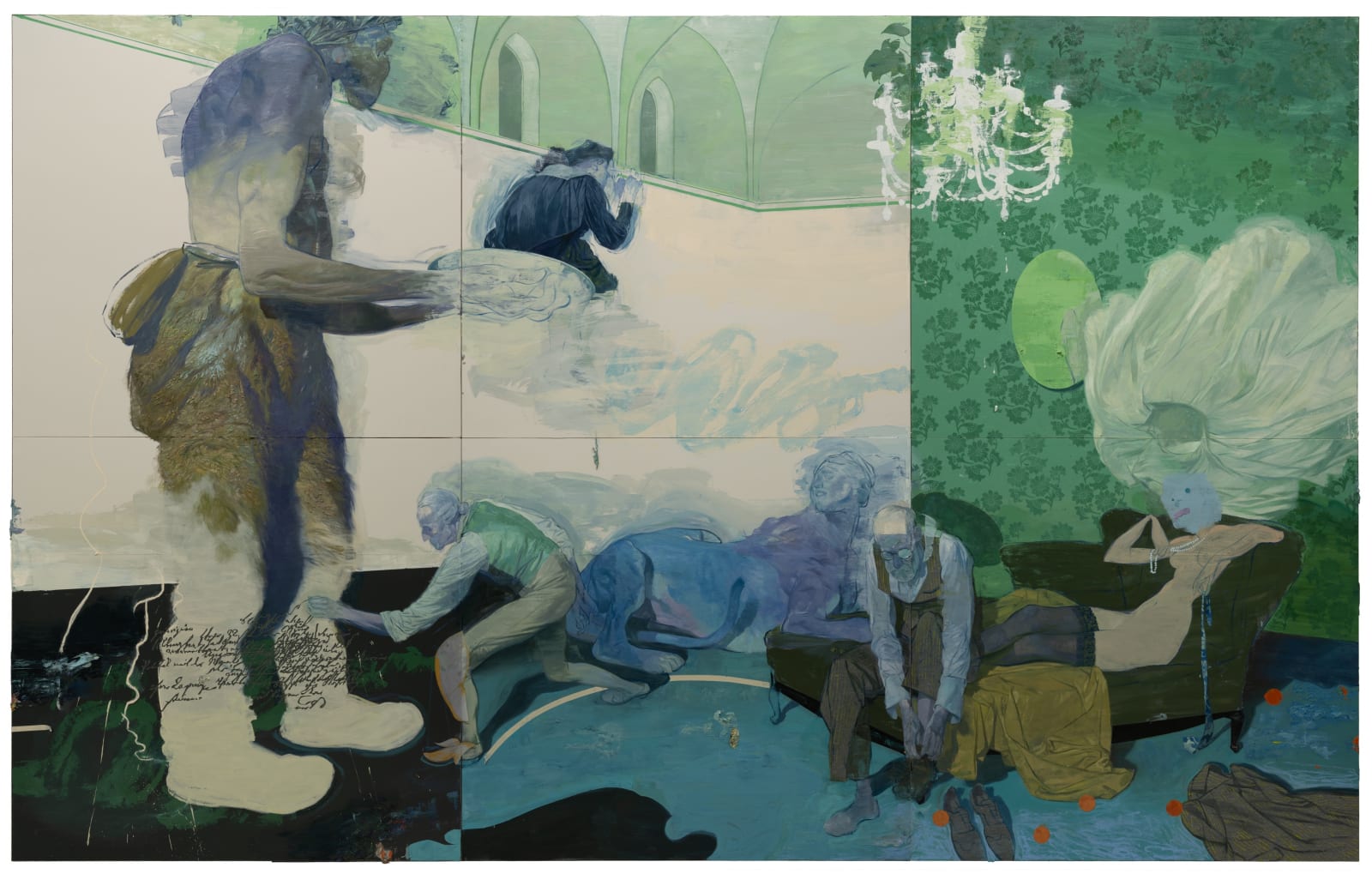Ruprecht Von Kaufmann
Die Vermessung Der Welt, 2023
Oil and collage (Mylar) on linoleum
306 x 487.5 cm
120 1/2 x 191 7/8 in
120 1/2 x 191 7/8 in
Copyright The Artist
The exhibition’s largest painting is also it’s centrepiece within which many of the defining ideas are touched upon and pulled together on a monumental scale, that very consciously flirts with...
The exhibition’s largest painting is also it’s centrepiece within which many of the defining ideas are touched upon and pulled together on a monumental scale, that very consciously flirts with and ridicules the genre of ‘history painting’.
The entire left side of the composition is dominated by a towering, giant and bearded figure, dressed in fur-trousers and crude boots. The giant is reminiscent of stone age men and is in fact inspired by reconstructions of the ‘Ötzi’, the 5300-year-old corpse of a man discovered in the ice of the Ötztaler Glacier. He’s the personification of many of the characteristics that have endured in modern man, but that have now lost their significance in our lives, like superstitions and conspiratorial thinking. Connecting the giant to our time is his large tin foil hat.
Standing against his lumbering movement is the elegantly-dressed figure of Emmanuel Kant, one of the pivotal figures of the Enlightenment, which with its science-based and rational approach introduced a new narrative to the world, a return to classical rationalism. Kant is leaning toward the giant ‘erasing’ his feet with his writing. The clear crystalline light of logical thought is shining into the dark brooding world of fairy tales.
Behind Kant, towards the right, the room changes into a more intimate scene, with a fresh green wallpaper, where Sigmund Freud is just about to get dressed, pulling on his socks. Sigmund Freud searched for connections to the conscious world in the meandering, seemingly senseless lines of the stories that unfurl in our uncurious minds. He is placed right on the gap between the two spaces that make up the composition, the pivotal element on which analytical thinking and emotions hinge upon. The world of fairy tales is the world of the human psyche, where deep fears, trauma and desire leave their mark and could be expressed in the realm of fictional stories. These desires here find a visual translation in the shape of an oversimplified faceless woman and a Sphinx.
The entire left side of the composition is dominated by a towering, giant and bearded figure, dressed in fur-trousers and crude boots. The giant is reminiscent of stone age men and is in fact inspired by reconstructions of the ‘Ötzi’, the 5300-year-old corpse of a man discovered in the ice of the Ötztaler Glacier. He’s the personification of many of the characteristics that have endured in modern man, but that have now lost their significance in our lives, like superstitions and conspiratorial thinking. Connecting the giant to our time is his large tin foil hat.
Standing against his lumbering movement is the elegantly-dressed figure of Emmanuel Kant, one of the pivotal figures of the Enlightenment, which with its science-based and rational approach introduced a new narrative to the world, a return to classical rationalism. Kant is leaning toward the giant ‘erasing’ his feet with his writing. The clear crystalline light of logical thought is shining into the dark brooding world of fairy tales.
Behind Kant, towards the right, the room changes into a more intimate scene, with a fresh green wallpaper, where Sigmund Freud is just about to get dressed, pulling on his socks. Sigmund Freud searched for connections to the conscious world in the meandering, seemingly senseless lines of the stories that unfurl in our uncurious minds. He is placed right on the gap between the two spaces that make up the composition, the pivotal element on which analytical thinking and emotions hinge upon. The world of fairy tales is the world of the human psyche, where deep fears, trauma and desire leave their mark and could be expressed in the realm of fictional stories. These desires here find a visual translation in the shape of an oversimplified faceless woman and a Sphinx.

